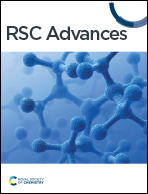Synthesis, electropolymerization and functionalization via click chemistry of N-alkynylated dithieno[3,2-b:2′,3′-d]pyrrole†
Abstract
A new N-alkynylated dithieno[3,2-b:2′,3′-d]pyrrole (DTP) monomer was synthesized using a Buchwald–Hartwig amination of 3,3′-dibromo-2,2′-bithiophene with pent-4-yn-1-amine. The obtained monomer was investigated for the possibility of a pre-polymerization modification via Huisgen 1,3-dipolar cycloaddition (“click”) reaction with azide-containing organic compounds. The synthesized N-alkynylated DTP monomer is soluble in a number of organic solvents and reacts with organic azides via “click” reactions in mild conditions, achieving high yields. The N-alkynylated DTP monomer and its “click”-modified derivative can be electropolymerized to form polymeric films. Herein, the synthesis and characterization of a “click” modified DTP monomer, its pre-modified derivative, and their corresponding polymers are described. The developed method is a facile route to synthesize a new generation of various N-functionalized DTP homopolymers.
![Graphical abstract: Synthesis, electropolymerization and functionalization via click chemistry of N-alkynylated dithieno[3,2-b:2′,3′-d]pyrrole](/en/Image/Get?imageInfo.ImageType=GA&imageInfo.ImageIdentifier.ManuscriptID=D2RA03265A&imageInfo.ImageIdentifier.Year=2022)


 Please wait while we load your content...
Please wait while we load your content...